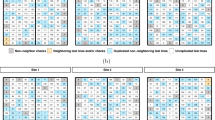Abstract
Three models were constructed for analyzing the population characteristics ofC. chinensis on stored beans; model A describing the whole reproductive process with a single equation, model B describing the three age-specific processes (oviposition, egg survival and larval survival) with separate equations, and model C which describes all these processes not for the whole habitat but for the individual beans comprizing it. The logit equation was employed here as a common basis to describe the density-response relationship involved. All three models showed very good fit to the experimental data obtained for both laboratory and wild strains of the weevil. The parameter values characterizing the population dynamics were, however, widely different between the two strains; the laboratory one which had been reared for some 500 generations showed significantly higher reproductive capacity, less sensitive and gentler response to crowding in both adult and egg stages, and more uniform egg distribution among individual beans, as compared with the wild strain newly introduced. Sensitivity analyses using these models suggested that these changes in population characteristics have been attained by the process of domestication or adaptation to stable laboratory conditions through a long period of time. This process seemed in effect to have optimized the population's performances in the laboratory environment. Evolutionary significance of such optimization was discussed with reference to the selection pressure which may have acted upon individuals.
Similar content being viewed by others
References
Bellows, T. S. Jr. (1982) Analytical models for laboratory population ofCallosobruchus chinensis andC. maculatus (Coleoptera, Bruchidae).J. Anim. Ecol. 51: 263–287.
Bellows, T. S. Jr. (1990) Population processes and dynamics of laboratory populations ofCallosobruchus spp pp. 373–383.In K. Fujii, A. M. R. Gatehouse, C. D. Johnson, R. Mitchell and T. Yoshida (eds.)Bruchids and legumes: economics, ecology and coevolution. Kluwer Academic Publishers, London.
Finney, D. J. (1978)Statistical methods in biological assay (3rd edition). Griffin, London.
Fujii, K. (1968) Studies on interspecies competition between the azuki bean weevil and the southern cowpea weevil III, some characteristics of two species.Res. Popul. Ecol. 10: 87–98.
Fujii, K., A. M. R. Gatehouse, C. D. Johnson, R. Mitchell and T. Yoshida (eds.) (1990)Bruchids and legumes: economics, ecology and coevolution. Kluwer Academic Publishers, London.
Fujita, H. and S. Utida (1953) The effect of population density on the growth of animal populations.Ecology 34: 488–498.J. Anim. Ecol. 44: 283–296.
Iwao, S. (1968) A new regression method for analyzing the aggregation pattern of animal populations.Res. Popul. Ecol. 10: 1–20.
Iwao, S. and E. Kuno (1971) An approach to the analysis of aggregation pattern in biological populations. pp. 461–513.In G. P. Patil, E. C. Pielou and W. E. Waters (eds.)Statistical ecology Vol. I. Spatial patterns and statistical distributions, Penn. State Univ. Press, University Park and London.
Kuno, E. (1983) Factors governing dynamical behaviour of insect populations: a theoretical inquiry.Res. Popul. Ecol. Suppl. 3: 27–45.
Kuno, E. (1991) Sampling and analysis of insect populations.Annu. Rev. Entomol. 36: 285–304.
Lloyd, M. (1967) ‘Mean crowding’.J. Anim. Ecol. 36: 1–30.
May, R. M. (1975) Biological populations obeying difference equations: stable points, stable cycles and chaos.J. Theor. Biol. 51: 511–524.
Maynard Smith, J. and M. Slatkin (1973) The stability of predatorprey system.Ecology 54: 384–391.
Oshima, K., H. Honda and I. Yamamoto (1973) Isolation of oviposition marker from azuki bean weevil,Callosobruchus chinensis (L.).Agr. Biol. Chem. 37: 2679–2680.
Shimada, M. (1989) Systems analysis of density-dependent population processes in the azuki bean weevil,Callosobruchus chinensis.Ecol. Res. 4: 145–156.
Shimada, M. (1990) Comparison of the density-dependent population process between laboratory and wild strains ofCallosobruchus chinensis (L.). pp. 361–371.In K. Fujii, A. M. R. Gatehouse, C. D. Johnson, R. Mitchel and T. Yoshida (eds.)Bruchids and legumes: economics, ecology and coevolution. Kluwer Academic Publishers, London.
Utida, S. (1941) Studies on experimental population of the azuki bean weevil,Calosobruchus chinensis (L.) I. The effect of population density on the progeny populations.Mem. Coll. Agr. Kyoto Imp. Univ. 48: 1–30.
Watanabe, N. (1988) A new proposal for measurement of the adjusted mean crowding through consideration of size variability in habitat units.Res. Popul. Ecol. 30: 215–225.
Author information
Authors and Affiliations
Rights and permissions
About this article
Cite this article
Kuno, E., Kozai, Y. & Kubotsu, K. Modelling and analyzing density-dependent population processes: Comparison between wild and laboratory strains of the bean weevil,Callosobruchus chinensis (L.). Res Popul Ecol 37, 165–176 (1995). https://doi.org/10.1007/BF02515817
Received:
Accepted:
Issue Date:
DOI: https://doi.org/10.1007/BF02515817




